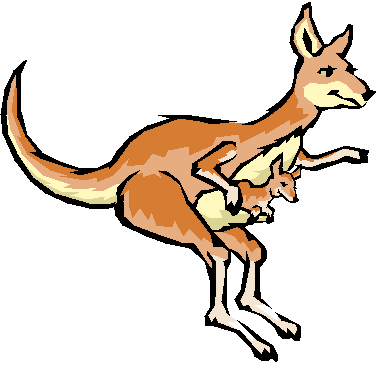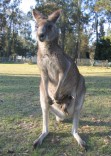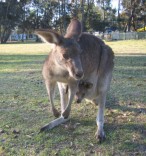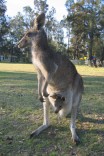LIFE HISTORY AND REPRODUCTION
The Red Kangaroo reproduces by sexual reproduction, however, it is quite different from placental mammals. Reproduction begins when the male courts the female. Of all kangaroo species, the Red Kangaroo has the least complex courtship activities. It begins when the male checks the female by sniffing her cloacal region as well as her pouch. If the female appears unreceptive to the male, he will back away and end the courtship. If a female is receptive she will urinate and the male with put the urine on his nose to sniff. A female will attract multiple males until she finds the largest one since males are able to sense sent signals given off by the female even at great distances. Sometimes during this process, the female will already have a joey in the pouch that is very close to final emergence. Next, the male begins stroking the female's tail and the female usually moves away, this process repeats a number of times. and the male will commonly make a clucking noise. The male continues to stay close by the female, sometimes up to 14 days. During this process more than one male may be present and usually the most dominant and largest one will copulate with the female. Copulation is rarely repeated in this species.
Once copulation has occurred the male is no longer responsible for the care of the joey. The fertilized egg will then undergo a usual gestation period of approximately 33 days. Only one young is carried at a time. When the kangaroo gives birth to the young, it is about the size of a lima bean. It is also hairless and is unable to see or hear. It then follows a trail of saliva left by the female that leads to the pouch. The joey climbs into the pouch where it remains for about one year. When the joey is born, it is completely unable to care for itself and will die if it does not reach the pouch because that is the site where it will complete its development.
Once the joey is safe inside its mother a number of stages take place. During the first stage the young must attach to a teat, therefore the mother must act in a manner that ensures survival of her young. Also, the mother consumes all of the joeys urine and feces and it is used to help in milk production. This also serves as a mechanism to keep the pouch clean. Until about 100 days the young begins to move and is continuously nourished by its mother's milk and around 150 days the joey's head will emerge. First emergence occurs at 190 days when the joey usually falls out of the pouch and leaves for very brief periods of time. Permanent emergence occurs when the kangaroo weighs about 4.5 kg. During this time the joey is able to leave its mother and explore. Next, the joey is weaned from its mothers milk. After weaning is complete, females joeys stay close to their mothers while males tend to wander off to develop their own home range. Males' sexual maturity varies with environmental conditions, but usually occurs around the age of 5. Females' sexual maturity also varies with environmental conditions and may range from 17 months to 5 years. Once the joeys are of sexual maturity the reproductive process repeats.




